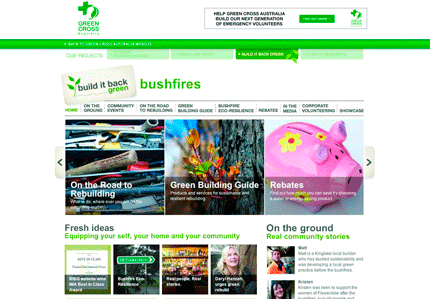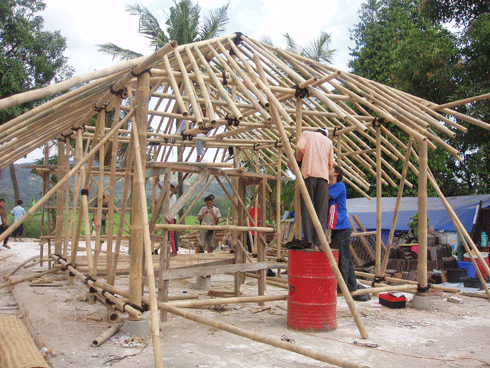
|
Published: 9 march 2011
Build it back green
In the chaos and suffering caused by natural disasters, the environmental impacts of relief and reconstruction efforts may not seem a priority. But in recent years, there has been a significant push to ‘Build it Back Green’.
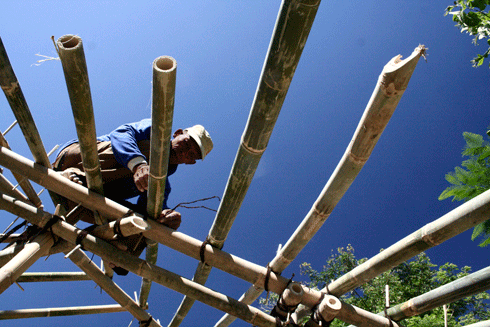
|
|
Reconstruction work in Yogyakarta (December 2006) after the earthquake that hit the region. Credit: International Federation of Red Cross and Red Crescent Societies
|
In 2009, having adopted a 30 per cent 2020 reduction target for greenhouse gas emissions, the Queensland government partnered with the Australian arm of the global environmental organisation Green Cross to advance the ‘Towards Q2: Tomorrow’s Queensland’ strategy. It was a prophetic alliance. In the wake of the devastation caused by recent extreme weather events in Queensland, Green Cross’s Build it Back Green initiative, which cut its teeth in the Hurricane Katrina reconstruction effort, is poised to play a major role in the recovery effort.
But in disaster aid circles, it is an earlier disaster, the 2004 Indian Ocean tsunami, that has become the touchstone for the vexed question of the environmental impacts of disaster relief. For those working in emergency shelter aid in the Asia Pacific, its lessons resonate strongly. The Indian Ocean tsunami relief effort involved one of the most comprehensive housing aid projects ever mounted, particularly in Aceh where over 100 000 homes were built by over a dozen different aid agencies. Since then many have tried to understand the successes and failures of the Aceh experience. Out of this self-reflection and evaluation, has come a new push for environmental sustainability in post-disaster shelter and reconstruction efforts.
Many of the houses built in Aceh are now vacant. The reasons are familiar to shelter aid workers who understand the problems of donor-driven instant housing solutions: houses built far from sources of livelihood, extended families, communities, and essential services such as schools and markets; houses that do not match family structures and modes of use of occupants and communities; hastily built houses with poor workmanship and substandard materials.
The environmental impact of the reconstruction effort in Aceh was also significant. The three main reconstruction housing models were based around a bungalow design using reinforced concrete, concrete block and brick work, steel framing and corrugated iron sheets. David O’ Brien, an architect based at the University of Melbourne is co-author of a study that compared the greenhouse gas emissions of the main housing models delivered as part of the international Aceh relief effort against traditional Acehenese housing. O’Brien says, ‘Emissions associated with the traditional house are negligible compared with those associated with the reconstruction types. There was an increased disparity between the emissions associated with traditional construction with organic materials as compared with contemporary techniques employing industrial products.’
Transitional shelter: more than a tent, less than a house
In the suffering and chaos of disasters, the line between emergency shelter and housing reconstruction can become blurred. ‘More than a tent, less than a house’ has become a mantra for emergency shelter workers. In crisis situations there is pressure to get things done fast, to relieve acute suffering. But donors and national governments of affected countries tend to want shelter relief money to go into housing rather than just transitional shelter. For national governments, the reason is fairly obvious – it eases the financial burden of reconstruction. On the part of donors, there is the desire to make a permanent contribution to the recovery of the affected nation, rather than the perceived temporary benefit of shelter.
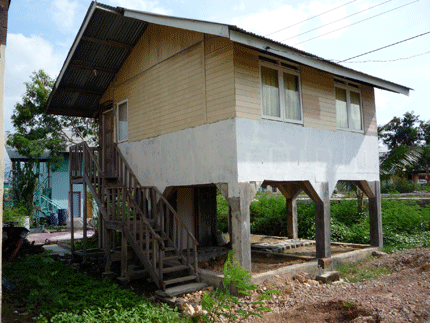
|
|
One of the houses built with aid money in Aceh following the 2004 Indian Ocean tsunami. Credit: David O’Brien
|
The risks associated with building housing under pressure in a short space of time are significant. There is, to put it bluntly, less time to get it right.
Dave Hodgkin is an Australian-born emergency shelter consultant to the aid sector and has a background in sustainable environmental building. He has worked throughout the Asia Pacific in various disaster zones, including Aceh, the 2006 Yogyakarta earthquake, and is currently consulting on shelter for the Pakistan flood relief effort. He explains how time, money and donor pressures played out in Aceh.
‘NGOs [non-governmental organisations] were under huge media and donor-driven pressure to get stuff done. And because there was so much money donated, you ended up almost with turf war for beneficiaries. It was like ‘where can I operate? I’ve got 20 million dollars and mum and dad donors in Scotland wanting results’. And that led to many agencies simply charging in, and there was an appalling level of chaos and overlap, and coordination mechanisms were heavily challenged.’
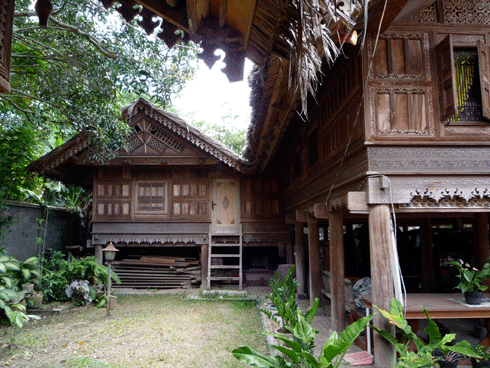
|
|
Traditional Acehenese house. Credit: David O’Brien
|
After Aceh, coordination of the international humanitarian aid sector underwent a comprehensive reform process. There are now clusters for specific areas such as shelter, water, sanitation and food. Each cluster has a lead coordinating agency – for shelter in natural disasters it is the Red Cross (International Federation of the Red Cross, the IFRC). Cluster coordination mechanisms are now much more open and participatory, and include technical working groups and a strategic advisory groups, made up of experts from the various different stake holders in that sector, such as local NGO’s government, and the UN.
The Yogyakarta earthquake of 2006 was one of the major proving grounds for the new ‘cluster’ system. Hodgkins explains that ‘after Aceh, the Red Cross made the commitment to lead the global shelter cluster in natural disasters and in Yogyakarta they took on both this coordination role and the separate role of conducting a major transitional shelter program of over 12 000 transitional shelters.’
Notably, the Yogyakarta cluster process involved engaging experts with local experience for the initial technical working group. Next most large agencies engaged local people in the process, through community consultations and pilot projects that fed back into the process. The result was a set of common guidelines for low-impact shelter of traditional bamboo frame construction, with walls of woven split bamboo (gedeg) and tarpaulin rooves that could later be covered with more permanent materials. These were usually traditional clay tiles (genteng), supplied so they could be reused later in permanent housing. The roof tiles in the area are generally fired with rice husks, as opposed to firing with scarce and valuable timber. Some changes were made to traditional methods to increase the earthquake resistance of the shelter such as bracing techniques and concrete foundation pads.
This design drew heavily on local traditional building materials and construction techniques. Communities received the materials and built the houses themselves. Volunteer supervisors from affected communities were trained and extensive instructional material was produced, much of it by students from Yogyakarta universities. While beneficiaries were strongly encouraged to follow the design, minor variations were common and generally not problematic as long as the general principles were followed.
Initial government desire for a ‘one step policy’ (straight from a tent to a house) had NGOs concerned about the risk of poor construction in the rush to rebuild. Government reluctance to support transitional shelter gave way to an arrangement whereby the aid agencies adopted a ‘roof first’ policy: the transitional shelter included the provision of brick roof tiles that could be re-used on permanent housing.
But as Dave Hodgkin explains, the shelter cluster is generally very clear about the limits of their role.
‘There are two critical elements of transitional shelter that people fail to think about. One is that if you put people into transitional shelter it gives them the time and the financial and mental space to think about building back better, to plan for better reconstruction. Their family is secure, they’re not rushing into reconstruction, they’ve got time, they can do it properly. The second one is that transitional shelter is an opportunity for engagement and discourse with the community about safe reconstruction. You’re within the community, you’re helping them build; it’s an opportunity for discourse. You’re buying access to introduce safe building concepts. I can build a bamboo frame without bracing, and wobble it and watch it fall, then rebuild it with bracing and show how it doesn’t fall down.’
Participation
A key feature of the Yogyakarta efforts was the way in which participation was built into the delivery. Not only were the houses built by beneficiaries, but the rollout also drew on the Javanese self-help culture of gotong royong. The value of owner-driven housing has long been a tenet of aid literature, and is now institutionalised as the ‘best practice’ approach to post-disaster reconstruction.
Sandra Durzo, a Geneva-based shelter advisor to the IFRC, says that one of the key lessons learnt by the aid community in recent times has been the value of ‘partnering up with communities rather than just inviting their participation’. Dave Hodgkin agrees. ‘We should be asking ourselves what civil society structures already exist to implement these programs. Using existing social capital and community coping mechanisms helps rebuild societies, not just structures, improving resilience and future disaster response capacity.’
It is clear that participation can have environmental benefits. ‘We now know’, say the authors of Building Back Better, a book on post-disaster housing aid, ‘that over the longer term, participatory processes deliver more sustainable solutions. They are a means of tapping the ingenuity of ordinary people and help to discover ways of solving problems which may not be part of the expert’s repertoire. They are tolerant, in other words, to the improvisation of the every day, which we know is the ‘user’s art’’.
Despite this, politics often gets in the way. The national government of Indonesia emerged from the Aceh aid efforts very wary of international shelter relief. While the global community moved towards increased participation and inclusivity, the government headed in the other direction, wishing to retain more control. In the government-coordinated relief efforts for the October 2010 Mentawai tsunami, community or NGO participation in designing shelter solutions has been minimal. Shelter agencies working with the government have been constructing with corrugated iron, plywood sheeting and frames built largely from freshly sawn rainforest timbers, rather than the coconut wood which was used by most agencies involved in the cluster-coordinated response to the September 2009 earthquake and tsunami.
|
After the 2009 Black Saturday bushfires in Victoria, Green Cross partnered with CSIRO, through an initiative called ‘Build it Back Green’, to provide information on sustainable and resilient housing design to fire-affected communities. |
CSIRO scientist Dr Matthew Inman and his team were invited by the Flowerdale community to attend early community meetings on recovery and reconstruction. |
‘We joined in the meetings and provided advice on house-scale questions of water efficiency, energy management, bushfire risk and other elements of sustainable design’, says Dr Inman. |
Dr Inman and his colleagues also talked to the community about synergies between some of these aims. ‘For example, the type of glass used in windows to make them more resistant to bushfire also makes them more energy efficient in terms of heating and cooling of the house.’ |
The Build it Back Green website, launched since Black Saturday, exemplifies the partnership approach of Green Cross Australia. A long list of industry, government and civil society partners have participated in developing the site which includes Australia’s first integrated guide to green finance options, including personal, home and car loans. |
Mara Bùn, CEO of Green Cross Australia, says that the ‘relationship between resilience and sustainability is the fundamental gap in Australia’s response to climate change’. On the resilience side of the equation, Green Cross aims to foster and support the coping mechanisms of communities, the ‘glue’ on the ground. ‘Resilient communities are those that know each other and engage with each other,’ says Bùn. To this end, Green Cross Australia runs a youth emergency volunteering program, Extreme Weather Heroes, that supports youth engagement in existing volunteer organisations such as the SES, Red Cross, and Rural Fire Services. |
Environmental advisors
Charles Kelly works as an advisor to relief agencies and specialises in environmental issues. He was environmental advisor to the Emergency Shelter Global Cluster in Haiti in 2008 and is a member of the Pro-Act network, a Swiss NGO that deploys environmental advisors to disaster scenes. It provides guidance on a wide range of issues, from dealing with large amounts of waste and debris to helping identify suitable – and unsuitable – sites for accommodating displaced people.
‘One of the things we focus on’, says Kelly, ‘is ensuring that environmental conditions are considered in recovery so that these efforts do not make communities more vulnerable to future disasters.’
Kelly contributed to the Green Reconstruction Policy Guidelines (GRRT), an extensive guide and training manual produced under the auspices of a partnership between the American Red Cross and the World Wildlife Fund that formed in the wake of the 2004 tsunami. The GRRT was written by ~30 technical and training specialists, an advisory committee and reviewers representing 17 agencies including the Red Cross, Oxfam, World Vision, and the United Nations Environment Programme.
As the guide points out, the intensive demand for raw materials in reconstruction ultimately impacts the environment and the people who depend on it. This demand can put strain on already depleted ecosystems which have a negative effect on the long-term sustainability of communities recovering from disaster. Issues covered by the GRRT include material selection, procurement policies, site selection, and participatory strategies.
In Jogjakarta after the earthquake, while the use of fast-growing and abundant bamboo over timber had clear environmental benefits, the management of the bamboo supply chain was not integrated into the transitional shelter programs. Much bamboo was clearcut or harvested using unsustainable techniques which resulted in deforestation of bamboo stocks in some areas, and in others will extend the time it takes for the stock to recover.
Shelter, natural disasters and climate change
The difficulty of transitioning from emergency relief to development assistance has long been an issue in the aid community, and the transition is particularly problematic in the area of shelter aid. In the fraught nexus of climate change, environmental degradation and natural disasters, this problem will only intensify.
According to Charles Setchell, the Shelter, Settlements, and Hazard Mitigation Advisor for USAID/OFDA, this reflects the ‘‘disasters by design’ view that how and where human settlements grow and change contributes to more and more disasters, suggesting that the roots of tomorrow’s disasters must be incorporated into today’s development policies and processes.’
This kind of forward thinking is behind a CSIRO partnership with AUSAID on long-term climate adaptation research that will inform AUSAID’s development policies. Collaborative urban case studies in Can Tho, Vietnam, and Makassar, Indonesia, are looking at how climate change, urbanisation, population growth and increased demand for resources, such as water, influence major urban infrastructure projects and urban planning.
More information
Building Back Better: Delivering people-centred housing reconstruction at scale: www.tinyurl.com/5w7xruj
Build it Back Green: www.builditbackgreen.org
Extreme Weather Heroes: www.extremeweatherheroes.org
Shelter Centre: www.sheltercentre.org
Lessons from Aceh: key considerations in post-disaster reconstruction: www.tinyurl.com/yaqo935
CSIRO and AUSAID Research for Development Alliance: www.tinyurl.com/4tyh38a


